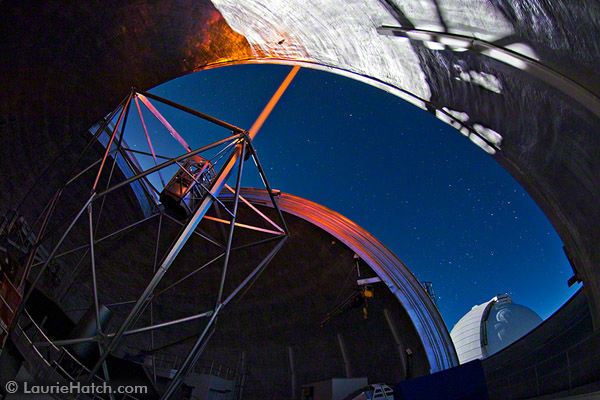Affiliated Research Centers & Facilities
The Department of Astronomy Astrophysics works closely with a large number of related research organizations and state-of-the-art facilities. Many are are located on campus, and others are administered by UCSC. These affiliated institutions are critical to our research and training goals. Links to the most prominent organizations are listed below:
 |
University of California Observatories (UCO): UCO is multi-campus research unit of the University of California that manages UC participation in both the Keck and Lick Observatories. Headquarters are on the UCSC campus. UCO astronomers hold joint appointments as professors in the Department of Astronomy and Astrophysics and conduct research and teach in the department. The UCO Instrument Laboratories are recognized world leaders in astronomical instrumentation, including optical design, fabrication, mechanical design, and instrument control software. |
 |
Other Worlds Lab (OWL): The Other Worlds Laboratory (OWL) is a new research initiative at the University of California, Santa Cruz (UCSC) that builds on the university’s historic successes in the study of planets inside and outside the solar system.
Within OWL, we seek to understand Earth’s place in the diversity of our solar system, use state-of-the-art techniques to find planets around other stars (“exoplanets”), understand how planets form, characterize their atmospheres, and understand if they are possible homes for life. |
 |
Lick Observatory, Mt. Hamilton, CA: The Lick Observatory is owned and operated by the University of California, with headquarters at UCSC. Lick was the first mountain-top observatory, built in 1888 with the 36-inch refractor, then the world's largest telescope. Current telescopes include the 3-meter Shane Reflector, the 1-meter Nickel Reflector, and the new 2.4- meter Automated Planet Finder, dedicated to finding extrasolar planetary systems (under construction). Lick is one of the world's best sites for high-resolution spectroscopy and is a leader in developing adaptive optics. |
 |
Laboratory for Adaptive Optics (LAO): Located on the UCSC campus, the Laboratory for Adaptive Optics enables hands-on exploratory research in the development of adaptive optics technology that benefits future implementations of adaptive optics systems on astronomical telescopes. The LAO is managed jointly by the Center of Adaptive Optics and by UCO. |
 |
The Kavli Summer Program in Astrophysics: The Kavli Summer Program in Astrophysics brings together scientists with a wide breadth of technical skills and research interests to solve topical outstanding problems in astrophysics. It operates every summer for 6 weeks and is hosted in alternance by various institutions world-wide and by the Santa Cruz campus. |
 |
Theoretical Astrophysics Santa Cruz (TASC): TASC is a vibrant new institute, spanning four UCSC departments that are involved in research in astrophysics and planetary sciences. Its fourteen participating faculty members make up the largest group of computational astrophysicists in the world. Building on this strength, TASC has begun a unique new interdisciplinary program in scientific computation and visualization in collaboration with members of UCSC's Digital Arts and New Media Center. TASC is also spearheading an effort to create a Ph.D. program in high-performance supercomputing, in partnership with the Baskin School of Engineering's Department of Applied Mathematics. Website is under construction. |
 |
Santa Cruz Institute for Particle Physics (SCIPP): SCIPP is an organized research unit within the University of California, specializing in experimental and theoretical particle physics and particle astrophysics. SCIPP builds experiments for particle accelerators, including the ATLAS detector at the LHC, and detectors for satellite observatories such as GLAST. It is also pursuing applications to other scientific fields, such as neurophysiology and biomedicine. SCIPP is a recognized leader in the development of custom readout electronics and silicon micro-strip sensors for state-of-the-art particle detection systems. |
 |
Keck Observatory, Mauna Kea, HI: These twin 10-meter telescopes are the world's largest telescopes and are jointly operated by the University of California, Caltech, and NASA. UC researchers receive 35% of the time. The Keck's 36-segment mirror design originated at UC, and UC astronomers have built the majority of Keck instruments. Keck data are widely used by the majority of UCSC observational students and postdoctoral fellows. |
 |
Thirty-Meter Telescope Project: The Thirty-Meter Telescope (TMT) is a future large segmented-minor optical and infrared telescope, proposed and run by a consortium made up of the University of California, Caltech, Associate Universities for Research in Astronomy (AURA), and the Association of Canadian Universities for Research in Astronomy (ACURA). The telescope consists of 738 1.2- meter segments and, when working with adaptive optics, will make images many times sharper than the Hubble Space Telescope. UCSC astronomers and engineers are working on the telescope's mechanical design, segment fabrication, segment support an alignment, instrumentation, and adaptive optics. |

